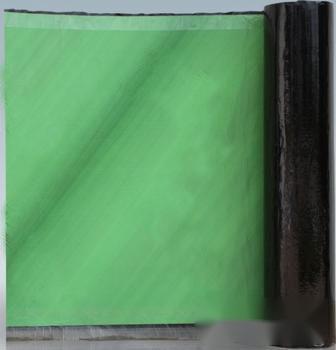One, Product Overview
PSA Reaction adhesive cross membrane wet-laid high polymer waterproofing membrane is a reaction type strong cross membrane high polymer self-adhesive waterproofing membrane bonded with freshly poured concrete or cement mortar. Unique activators and soaking agents are added to the self-adhesive layer to enhance its creep properties, allowing it to penetrate into the pores and capillaries of concrete, forming physical adsorption and dovetail action, while also undergoing chemical reactions with concrete and cement gel to form a chemical cross-linking structure, ensuring strong bonding between the membrane and the substrate, forming a tight, sealed waterproof layer.
Two, Product Classification
PSA Reaction adhesive cross membrane wet-laid high polymer waterproofing membrane is classified as single-sided adhesive (S) and double-sided adhesive (D), and divided into Type I and Type II according to performance.
Three, Product Specifications
Full thickness of the membrane: Single-sided adhesive (S): 1.2 mm, 1.5mm, 2.0 mm; Double-sided adhesive (D): 1.5mm, 2.0 mm. Type I base can choose strong cross membrane or polyester film as needed; Type II base is a strong cross membrane.
Four, Product Marking
The wet-laid code is (W), high polymer waterproofing membrane (P).
20m 2.0mm single-sided adhesive Type I PSA-228 reaction adhesive cross membrane wet-laid high polymer waterproofing membrane is marked as:
W P I S 2.0mm 20m GB/T 23457-2009
Five, Executive Standard
GB/T 23457-2009 "Pre-laid/Wet-laid Waterproofing Membrane".
Six, Product Features
PSA Reaction adhesive cross membrane wet-laid high polymer waterproofing membrane is made of cross-laminated high-density polyethylene film. The film is composed of multiple layers of film overlaid at a 45° angle, with each layer cut in a diagonal direction. Its strong cross-laminated structure differs from ordinary single-layer or multi-layer film structures, providing thermal stability, dimensional stability, two-way tear resistance, high strength, and high elongation rate.
Excellent dimensional stability. It can maintain its size without deformation.
Two-way tear resistance. The cross mesh structure effectively prevents wrinkles and bulges after construction.
UV resistance. Ensures use in high temperature outdoor conditions.
High strength and high elongation rate. Excellent performance in high and low temperature resistance.
Unique puncture resistance. Excellent nail rod water tightness, better waterproof performance than ordinary film.
Seven, Construction Method
1, Wet-laid method: Spread plain cement slurry evenly on the base layer (3-5mm thick) for the transition bonding between the base layer and the self-adhesive surface of the membrane. After peeling off the isolation film on the self-adhesive surface of the membrane, bond it directly to the transition bonding layer.
When constructing the facade, a certain amount of special adhesive can be added to the cement slurry to increase its viscosity.
2, Process Flow
Base layer cleaning→moistening the base layer (this step is not required if the base layer is already moistened)→positioning, snapping lines→applying cement slurry→laying self-adhesive waterproofing membrane→tapping the surface of the membrane, lifting the slurry→airing for 24 hours to 48 hours→trimming the ends of the membrane, sealing→finishing, acceptance.
3, Key Points of Operation
Base layer treatment: The surface should be treated first to make the base layer solid, clean, and thoroughly moistened, with no standing water.
Preparation of plain cement slurry: 42.5 cement: water = 2:1, adjust the amount of water according to the base surface and climatic conditions, soak the cement and remove the surface slurry, then mix well with an electric mixer.
Applying cement mortar: Depending on the flatness of the base layer on-site, determine the thickness of the cement slurry to be applied, usually 3-5mm. When applying, pay attention to compacting and smoothing. The range













